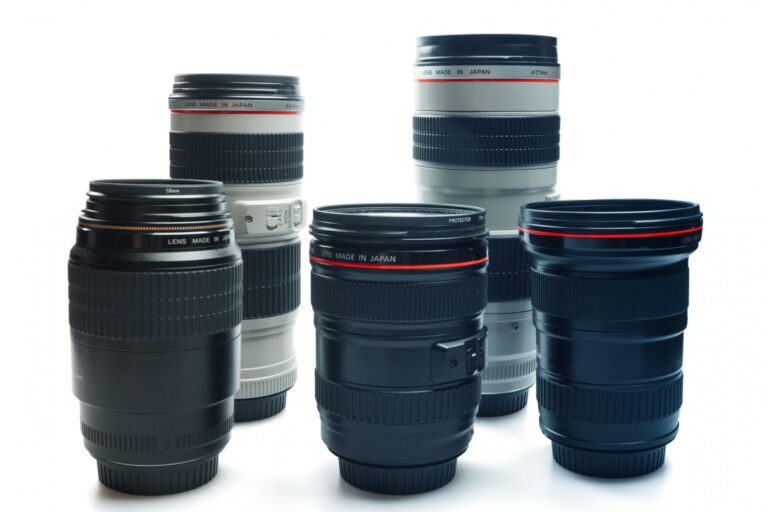Wildlife photography is a thrilling and challenging art that requires the perfect gear to capture the essence of nature’s beauty. A camera lens is undoubtedly the most critical equipment for any wildlife photographer. It allows you to capture the subject’s finest details and showcase its attractive characteristics.
However, choosing the best camera lens for wildlife photography can be daunting, especially for beginners. Factors such as focal length, aperture, image stabilization, and build quality must be considered before making a final decision. In this blog post, we’ll explore the importance of having a good camera lens for wildlife photography and the essential factors to consider when choosing one. So, whether you’re a seasoned pro or an amateur photographer, read on to discover the best camera lenses for wildlife photography.
Table of Contents
Types of Camera Lenses for Wildlife Photography

Wildlife photography is a thrilling and rewarding experience that requires a high-quality camera and lens. When it comes to capturing wildlife, having the correct type of camera lens is crucial. Telephoto lenses are a popular choice among wildlife photographers, thanks to their long focal lengths and ability to capture detailed shots from a distance. These lenses are perfect for shooting shy or dangerous animals that are not approachable.
On the other hand, super-telephoto lenses are ideal for capturing extremely far-away subjects or taking detailed images of small animals. These lenses can be heavy and expensive, but they offer superior clarity and sharpness.
Zoom lenses are a versatile option for wildlife photographers who need the flexibility to capture wide-angle shots and close-ups. Their adjustable focal lengths allow photographers to capture a wide range of images without changing lenses. Whatever your needs and preferences, choosing the right type of camera lens is essential for capturing stunning wildlife photographs that stand out from the crowd.
Key Features to Consider When Choosing a Camera Lens for Wildlife Photography

Choosing the right camera lens is essential for capturing stunning and vibrant images. Among the various features you should consider, aperture, focal length, image stabilization, weight and size, and weather sealing are the key factors to keep in mind.
The aperture is the commencement through which light enters the camera lens. It defines the depth of field and the quantity of light that arrives at the camera’s sensor. Choosing a lens with a wide aperture, such as f/2.8 or f/4, will allow you to capture sharp images in low light conditions and create a blurred background that isolates your subject.
Focal length is another important consideration. A longer focal length, such as 400mm or 600mm, is ideal for capturing wildlife from a distance, while a shorter focal length, such as 70mm or 100mm, is more suitable for capturing wider shots.
Image stabilization is a component that helps to decrease camera shake and produce sharper images, especially when shooting in low-light conditions. A lens with image stabilization technology is highly recommended for wildlife photography.
Weight and size are also important factors to consider when choosing a camera lens for wildlife photography. A too-heavy or bulky lens can be tiring to carry around, especially if you are hiking or traveling long distances.
Finally, weather sealing protects your lens from dust, moisture, and other elements. A lens with good weather sealing will ensure your equipment stays safe and functional even in challenging outdoor conditions.
When selecting a lens for wildlife photography, you need to consider several factors, including aperture, focal length, image stabilization, weight and size, and weather sealing. By considering these features, you can choose a lens that will help you easily capture stunning wildlife images.
Top Camera Lenses for Wildlife Photography
1. Canon EF 100-400mm f/4.5-5.6L IS II USM

The Canon EF 100-400mm f/4.5-5.6L IS II USM is a prime telephoto lens with impressive optical performance and versatile handling. As a part of Canon’s prestigious L-series lenses, it’s built to meet professional standards and is highly regarded by photographers who demand the best.
Regarding technical specifications, the lens boasts a zoom range of 100-400mm and an aperture range of f/4.5-5.6. It’s equipped with a fast and accurate autofocus system and image stabilization technology, making it ideal for capturing subjects in motion. Besides, its durable structure ensures that it can withstand heavy use in demanding conditions.
This lens’s optical performance is outstanding, delivering sharp, detailed images with a minimal warping and chromatic anomaly. It’s advanced lens coatings, and design makes it resistant to flare and ghosting, ensuring that your pictures are always of the highest quality.
The handling and build quality of the Canon EF 100-400mm f/4.5-5.6L IS II USM are equally impressive. It features a smooth and responsive zoom ring that makes it easy to adjust the focal length and a sturdy tripod mount that provides stability when shooting with longer exposures. The lens is also weather-sealed to protect against dust and moisture, making it a reliable choice for outdoor photography.
Sample images of this lens showcase its capabilities in various use cases, including wildlife, sports, and landscape photography. Whether shooting portraits from a distance or capturing the action on the field, the Canon EF 100-400mm f/4.5-5.6L IS II USM delivers outstanding results.
Compared to other L-series lenses, the Canon EF 100-400mm f/4.5-5.6L IS II USM stands out for its versatility and ease of use. While other lenses in the series may have narrower focal lengths or faster apertures, this lens strikes an excellent balance between performance and practicality, making it a top choice for many photographers.
2. Nikon AF-S FX NIKKOR 200-500mm f/5.6E ED
The Nikon AF-S FX NIKKOR 200-500mm f/5.6E ED camera lens is an impressive piece of equipment for any photography enthusiast. At a weight of 5 pounds, it is a hefty lens, but it is designed for versatility and mobility. The lens features a zoom range of 200-500mm, making it ideal for capturing distant subjects such as wildlife or sporting events.
It also has a maximum aperture of f/5.6, which provides a bright and clear image, even in low light conditions. The lens has a silent wave motor (SWM) that allows for fast and accurate autofocus, and the manual focus override switch ensures the user has full control over their images.
Regarding technical specifications, the Nikon AF-S FX NIKKOR 200-500mm f/5.6E ED has a maximum angle of view of 12 degrees, 20 minutes, and a minimum focus distance of 7.2 feet. The lens has 19 elements in 12 groups, including three extra-low dispersion (ED) glass elements that help minimize chromatic aberrations and distortions. Additionally, the lens has a Super Integrated Coating (SIC) that helps reduce ghosting and lens flare.
The optical performance of this lens is excellent. The images produced are sharp, and the colors are vibrant and accurate. The lens’s vibration reduction (VR) feature compensates for camera shake, making it easier to shoot handheld. The VR also has a sports mode that tracks fast-moving subjects and maintains image stability.
The Nikon AF-S FX NIKKOR 200-500mm f/5.6E ED is built to withstand heavy use. The lens is constructed of high-quality materials and has a weather-sealed barrel that protects against dust and moisture. The lens also features a removable tripod collar, allowing easy mounting on a tripod.
Overall, this lens is an excellent option for photographers who need a long-range zoom lens. The sample images captured with this lens are impressive and show the lens’s capabilities. It is also worth comparing the lens with similar lenses in the market,
Such as the Sigma 150-600mm f/5-6.3 DG OS HSM Sports lens or the Tamron SP 150-600mm f/5-6.3 Di VC USD G2 lens. But, the Nikon AF-S FX NIKKOR 200-500mm f/5.6E ED stands out with its excellent optical performance, handling, and build quality, making it a worthy investment for any photographer looking to capture distant subjects.
3. Sony FE 100-400mm f/4.5-5.6 GM OSS
The Sony FE 100-400mm f/4.5-5.6 GM OSS is an impressive camera lens with the outstanding optical performance. This lens is the perfect choice for capturing wildlife, sports, and actionIts exceptional zoom range can capture subjects in sharp detail from far away. Technically, it boasts a 9-blade circular aperture that delivers stunning bokeh and minimizes distortion.
The lens features a Direct Drive SSM autofocus system, which allows for fast and accurate focus tracking. The handling and build quality are exceptional, with weather-sealed construction and a sturdy, ergonomic design.
In terms of optical performance, this lens excels with superb sharpness, contrast, and color rendering. The Sony FE 100-400mm f/4.5-5.6 GM OSS produces stunning sample images with excellent detail, even at maximum aperture. It is a versatile lens that can be used for various applications, including portrait, landscape, and architecture photography.
Compared to other lenses, the Sony FE 100-400mm f/4.5-5.6 GM OSS stands out with its exceptional build quality and impressive image quality. This lens is a top-notch option for photographers who looking for a versatile, high-performance telephoto lens.
4. Tamron SP 150-600mm f/5-6.3 Di VC USD G2
The Tamron SP 150-600mm f/5-6.3 Di VC USD G2 camera lens is a versatile and reliable option for photographers capturing distant subjects. With a zoom range of 150-600mm, this lens can be operated for a wide range of photography styles, from wildlife and sports to portraits and landscapes.
In terms of technical specifications, this lens boasts a maximum aperture range of f/5-6.3, with a minimum focus distance of 7.22 feet. The lens also features Tamron’s Vibration Compensation (VC) technology, which helps to reduce camera shake and produce sharper images.
Regarding optical performance, the Tamron SP 150-600mm f/5-6.3 Di VC USD G2 delivers impressive sharpness, contrast, and color accuracy, even at the extreme ends of the zoom range.
The handling and build quality of the lens are also noteworthy, with sturdy construction and comfortable grip that make it easy to use for extended periods. Sample images captured with this lens showcase its ability to produce stunning images, even in challenging lighting conditions.
Whether you’re a professional or an enthusiast, the Tamron SP 150-600mm f/5-6.3 Di VC USD G2 is a lens that should be considered for its excellent performance and versatility.
Compared to other lenses in its class, this lens holds its own. It offers a compelling combination of features and performance, making it an attractive option for any photographer looking to expand their kit.
5. Sigma 150-600mm f/5-6.3 DG OS HSM Sports Lens
The Sigma 150-600mm f/5-6.3 DG OS HSM Sports Lens is a high-performance zoom lens for sports and wildlife photography. This lens proposes an outstanding zoom range of 150-600mm, making it suitable for capturing distant subjects.
Regarding technical specifications, the Sigma 150-600mm f/5-6.3 DG OS HSM Sports Lens features a maximum aperture range of f/5-6.3, with a minimum focus distance of 8.5 feet. The lens also features Sigma’s Optical Stabilizer (OS) technology, which helps to reduce camera shake and produce sharper images.
Regarding optical performance, the Sigma 150-600mm f/5-6.3 DG OS HSM Sports Lens delivers exceptional sharpness, contrast, and color accuracy, even at the most extended zoom ranges.
The handling and build quality of the lens are also impressive, with sturdy construction and weather-sealing that make it suitable for use in challenging conditions. Sample images captured with this lens showcase its ability to produce stunning images with vibrant colors and impressive detail.
Whether you’re a professional or an enthusiast, the Sigma 150-600mm f/5-6.3 DG OS HSM Sports Lens is a lens that should be considered for its excellent performance and versatility. Compared to other lenses in its class, this lens holds its own. It offers a compelling combination of features and performance, making it an attractive option for any photographer looking to capture high-quality images of sports or wildlife.
Conclusion
In summary, having the right lens is crucial to capturing stunning and detailed images when it comes to wildlife photography. The Tamron SP 150-600mm f/5-6.3 Di VC USD G2 and the Sigma 150-600mm f/5-6.3 DG OS HSM Sports Lens are excellent options offering impressive zoom ranges, optical performance, and handling and build quality.
These lenses have been designed with image stabilization and weather-sealing features to ensure they can perform well in challenging conditions. Additionally, the sample images produced by these lenses demonstrate their ability to capture the beauty and detail of wildlife.
Ultimately, the choice between these lenses will depend on individual preferences and needs, but both lenses are solid choices for photographers looking to capture high-quality wildlife images. In conclusion, we recommend that wildlife photographers consider these lenses and evaluate their unique features and performance to make an informed decision.

Frequently Asked Questions
A: Choosing the best camera lens for wildlife photography depends on various factors, such as your budget, the type of wildlife you plan to capture, and the shooting conditions.
A: Generally, a focal length of 300mm or higher is recommended for wildlife photography, as it allows you to capture distant subjects without compromising image quality. However, the ideal focal length can vary depending on the type of wildlife your photograph and the shooting conditions.
A: Zoom and prime lenses have advantages and disadvantages for wildlife photography. Zoom lenses offer versatility and convenience, allowing you to change focal lengths without switching lenses. On the other hand, prime lenses tend to have wider apertures, which makes them better suited for low-light conditions and allows for a shallower depth of field, which can create more dramatic and artistic images.
A: Teleconverters can be a valuable accessory for wildlife photography, as they allow you to increase the focal length of your lens without purchasing a new one. However, teleconverters can also reduce image quality and autofocus speed, so choosing a high-quality teleconverter compatible with your lens is very important.
A: The best aperture for wildlife photography depends on the situation. If you want to capture a sharp image with a lot of detail, you should choose a more miniature aperture, such as f/8 or f/11. However, If you want to create a blurred background and draw attention to the subject, choose a more comprehensive aperture, such as f/2.8 or f/4.
A: Yes, you can use a crop-sensor camera for wildlife photography. In fact, crop-sensor cameras can be advantageous as they provide extra reach, effectively increasing the focal length of your lens. However, crop-sensor cameras also have a smaller field of view, making capturing wide-angle shots more difficult.
A: There is no one “best” brand of a camera lens for wildlife photography, as different brands offer different strengths and weaknesses. Some of the most popular brands for wildlife photography include Canon, Nikon, Sony, and Fujifilm. It is important to choose a brand that offers a wide selection of high-quality lenses that are compatible with your camera.
A: One of the best ways to protect your camera lens while photographing wildlife is to use a lens hood, which can help prevent damage from accidental bumps or scratches. Additionally, invest in a protective filter, which can help protect the front element of your lens from dirt, dust, and moisture.






